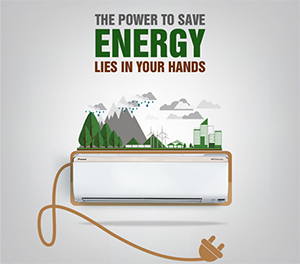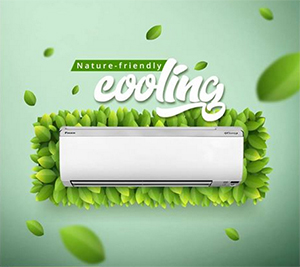
There is need to save ozone while keeping cool. A sustainable approach to refrigerants is the only way,
writes V Rishi Kumar
It was Albert Einstein who famously said, "We can't solve our problems with the same thinking we used when we created them." These words succinctly sum up the concerted response to global warming and the impact it is having on climate.
A number of factors cause climate change and the effort to address them has been multi-fold. One area that has been identified as a key concern is the large-scale use of refrigerants, which have a direct bearing on ozone depletion.
From chlorofluorocarbons, which we once used, we have gradually drifted to hydrofluorocarbons (HFCs), which are less ozone-depleting.
The quest to explore other options continues as one type of refrigerant does not meet the diverse requirements of air-conditioning and refrigeration. The temperature requirement is 18 degrees C to 24 degrees C for air-conditioning and for refrigeration, it is anywhere between minus 30 degrees and plus 20 degrees C.
Significantly, R1234yf, a refrigerant used in automobiles to conform to EU norms, which is imported, costs about 40 times more than HFC 134Alpha.
Rachel Kyte, Chief Executive Officer of Sustainable Energy for All (SEforALL), and special representative of the UN Secretary General for Sustainable Energy for All, in a report on "Chilling prospects: Providing Sustainable Cooling for All", released during the UN's High-level Political Forum in New York recently, says it's a wake-up call. "It calls our attention to the growing, unprecedented risks for people who cannot access cooling today."
There has been unprecedented growth in refrigeration for cooling and heating due to urbanisation in the world with 7.2 billion people. Hence, of the 17 Sustainable Development Goals identified, four are related to urbanisation, water conservation, sustainability and refrigeration.
The Paris Agreement and the Montreal Protocol's Kigali agreement of 2016 have brought attention to the close linkages between cooling, energy demand and climate change and aim to address these challenges. The objective is to phase down production and use of HFCs with high global warming potential by more than 30 per cent, over the next 30 years.

As a logical step, there has been a concerted effort worldwide to cut down on the use of HFCs, a major refrigerant now in use, by 80 per cent over the next 30 years. This triggers an opportunity and challenges to develop new cooling technologies and use of more environment-friendly refrigerants, making it imperative for governments and industry to find solutions that have less global warming potential.
The story closer home
In India too, it is important to take the bull by the horns. Ravichandran Purushothaman, President of Danfoss India, part of the Denmark-based Danfoss, feels sustainable cooling is the only way forward. "With less than 10 per cent penetration of air-conditioning, under 5-6 per cent of refrigeration in India, it has huge potential to grow. This brings a number of challenges and needs some innovative thinking and solutions."
As people migrate to urban areas, the pattern of life is changing, along with food habits. In the past, food was consumed where it was produced. Today, food is produced at one place and consumed elsewhere.

"While dealing with perishable food items, we need to create adequate capacity for cooling. Along with the cooling required for living, the use of refrigerants has become paramount for policy-makers to consider," says Purushothaman.
Experts point out that the cooling technology now in use is based on vapour absorption technology and was put in place about 100 years ago. So, the scope for innovation is enormous and could be a good opportunity for India.
Purushothaman agrees wholeheartedly. "India does not make refrigerants and continues to import them. Due to high urbanisation and need to store food, the demand for cooling and refrigeration will go up significantly. This also means we will have to import all these. Therefore, the government must encourage making these refrigerants in India as a part of its 'Make in India' initiative. Or else we will become a net importer, like we are in the case of oil and electronics."
However, this may be more easily said than done. India is quite complex with five climatic zones where humidity and temperature vary from one zone to another, requiring different innovations. But solutions are being explored.
The government, along with NITI Aayog, is working towards a National Cooling Action Plan, where it will seek to address climate change in a holistic manner. One of the issues is an HFC phase-down. But here too, there are challenges in the absence of a clear alternative technology pathway and global financing issues.
Ideas unlimited
Nevertheless, as the need arises, local and innovative solutions are bound to crop up. For instance, the concept of 'District Cooling' for a Greenfield smart city like Amaravati in Andhra Pradesh. Here there is talk of the entire 30 km by 30 km area being taken up in a holistic manner. This will help save energy and improve efficiency, Ravichandran points out.
Vapour compression today consumes 20 per cent of the global energy and is steadily growing as penetration of refrigeration and air-conditioning gains pace in a developing India.
CO2 potential
Pramod Kumar, Associate Professor, Department of Mechanical Engineering, Indian Institute of Science, Bengaluru, says, "IISc and IITM are jointly working on research on Trans-critical CO2 and other natural refrigerant-based cooling systems for tropical countries with high ambient temperatures. Designing a suitable CO2 system for higher ambient temperatures is challenging due to higher discharge temperatures from the gas cooler."
"Although CO2 systems suffer a slight performance degradation in comparison to the synthetic refrigerants, the overall benefit of using natural refrigerants is far higher in terms of the greenhouse emissions. When considering life cycle analysis of the system, which includes production of the refrigerant, transport, leakage and system footprint, compared to slight reduction in COP, CO2 systems fare much better," he explains.

Ravichandran concurs, saying, "Co2 will slowly and surely find its place as a potential viable refrigerant in the future because of its competitive pricing versus other refrigerants. India has the great chance to leapfrog using Co2 as it helps us to transition to a safer refrigerant just in time when the penetration gains pace as India urbanises rapidly."
Kanwal Jeet Jawa, Managing Director and CEO of Daikin Air Conditioning India, arm of Japanese MNC Daikin, says, "As responsible heating, ventilation and air-conditioning (HVAC) global leaders, we are aware that rampant usage of refrigerants has so far contributed to extreme weather patterns, causing destruction of crops and property. So, the next generation refrigerant, HFC 32, is the only solution to protect our future. I am foreseeing a rise in ACs to 30 million by 2030 from the five million being used today, pushing a 100-fold rise in demand for electricity in the country."
Daikin has made available its nine basic patents in India free of cost to Indian AC manufacturers, subject to signing of non-assertion agreement. Danfoss too is seeking to promote more innovation in this space and offers a full programme of control components for CO2, ammonia and hydrocarbons.
Others believe the move towards environment-friendly buildings is going to help in the long run. S Srinivas, Deputy Executive Director at CII Indian Green Building Council, says, "With a strong registered green building base of over 5.3 billion sq ft both residential and commercial, where about 92 per cent are IGBC rated, air-conditioning is an important element in rating the buildings. This is also playing a positive role towards better refrigerants."
Big implication
Back on the global stage, the Kigali agreement has both financial and technological implications towards research and development that could lead to new types of refrigerants that are more environment-friendly. And a comprehensive Action Plan could hold the key to a sustainable road map.
Across the world, discussions continue on how to reduce the impact of direct emissions from refrigeration and air-conditioning systems.
Following the decision to phase down HFC use, a new trend of low global warming-potential refrigerants is in focus.
The International Energy Agency, in its global report, 'Future of Cooling', expects the capacity of space cooling to jump from 850 GW in 2016 to 3,350 GW in 2050, an increase equal to the total generating capacity of the US, Europe and India.
And India and South-East Asia account for the largest shares of the growth in CO2 emissions from air-conditioning. What is scary is that by 2050, India could account for 30 per cent of global space cooling, compared to 8 per cent in 2016.
source: The HINDU Business line

